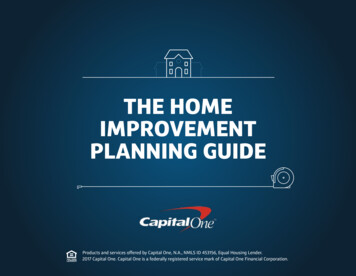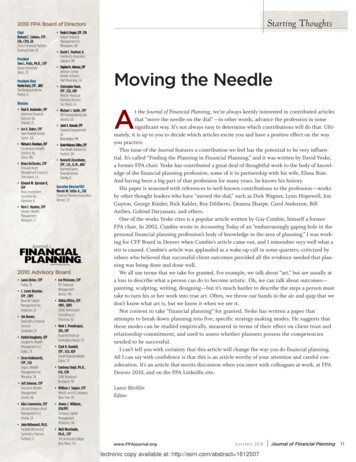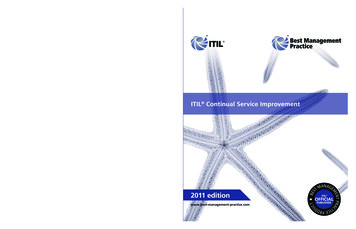
Transcription
THE HOMEIMPROVEMENTPLANNING GUIDEProducts and services offered by Capital One, N.A., NMLS ID 453156, Equal Housing Lender.2017 Capital One. Capital One is a federally registered service mark of Capital One Financial Corporation.
The Home Improvement Planning GuideThe Home Improvement Planning GuideHome improvement business is booming. In 2016,homeowners spent more than 361 billion on homerepairs and renovations1—setting an all-time high.Living spaces were made more comfortable. Heatingand cooling systems were upgraded. Electrical andplumbing systems were brought up to code. Every partof the home was open for change.The average homeowner spent 60%more on home projects year-over-year.2There’s a lot of value in home improvements butthere’s not always a lot of fun. Chaos, clutter and costssometimes add up to stress. While this guide won’tquiet the saws or sweep up the sawdust, it will makesense of the chaos. It’s a handy guide to help plan,budget and manage home improvement projects ofalmost any size.12“Homeowners Spent a Record Amount on Remodeling—but on What, Exactly?” Realtor.com, 2017.“2017 True Cost Report.” HomeAdvisor, 2017.2
The Home Improvement Planning GuideThe Home Improvement Planning GuideTable of ContentsLay Out Your Goals page 4Goals Worksheet page 5Organize the Details page 6Planning Pro Tips page 7Budget, Budget, Budget page 8Find a Contractor page 10Figure Out Financing page 12Enjoy! page 143
The Home Improvement Planning GuideSTEP 1.Lay Out Your Goals 20,000Average cost of addinga solar power systemto a roofTo see how much a solarroof can save you, clickthe image below.Source: “How Much Does it Cost to InstallSolar Panels?” Home Advisor, 2016.Before you get started, think about why you’re working on this particular remodeland what you hope to accomplish. That will make a difference when setting a budget,getting financing and hiring contractors.On one end of the spectrum are repairs and improvements that are “good enough.”For example, you need an extra room but it doesn’t have to be fancy, or you’rereplacing cracked flooring with basic linoleum or laminate. You might make thesechanges so you can sell the home or bring it to a basic level of safety.On the other end are improvements that drastically increase the value and aestheticcharm of your home: a spa tub in the bathroom, solar panels on the roof or a newrental apartment in the refinished basement. You’re probably planning to stay in yourhouse for a few years to enjoy the upgrades, and you want to put the funds and focusinto the high-quality finishes that justify your investment.Though it’s not time to make a budget just yet, this is where you start thinking aboutthe basic size of the project. Are you talking about a few hundred dollars for newpaint and fixtures, or are you imagining 30,000 and a team of contractors makingsome big changes?4
The Home Improvement Planning GuideGoals WorksheetThe rooms where I spend the most time areThe rooms I really love in my home areI wish my home was moreThe rooms I’d like to change areHow can I change these rooms to be more like the rooms I love?5
The Home Improvement Planning GuideSTEP 2.Organize the Details30%Once you get an idea of the kinds of home renovations you’d like to make it can be hardto wait. But it’s worth it to make a plan rather than dive right in. To craft the smartestapproach, take the following into account:of all professional homeremodeling projects comefrom saving failed DIYattemptsShort-term move vs.staying put.Do you have another place tostay while the work’s beingdone? It could alleviate stress topack your bags for a few weeksand come home in time for the“big reveal.”Source: “Thinking About Home Remodeling?Start Here.” National Association of HomeBuilders, 2017.Time of year.Spring and summer promiselong, warm days for sawing,hammering and painting, butthey’re also the busiest timesfor contractors. Try to scheduleyour remodel for a few weeksbefore or after the popularseason – call in March about anew deck, not June.Hire contractors or DIY.DIY makes sense for people whoare handy, have plenty of timeand don’t get stressed easily.But for everyone else, it’s betterto hire contractors. Yes, theycost money, but they save youfrustration, time and poorlydone work that might be unsafeor unsightly.After examining your options, you might decide to put your start date on hold for afew months.6
The Home Improvement Planning GuidePlanning Pro Tips1 Gather Ideas From EverywhereWhile you plan, keep your eyes openfor inspiration. Take pictures of nicerooms, bold colors, or cool pieces offurniture—wherever you see them.Online tools like PinterestTM canbe really useful for making moodboards and referring to them whenyou’re making decisions.2 Draw On ItCheck out the Houzz app, a homedesign and drawing tool. Use yoursmartphone to take pictures of yourhome, then redraw walls, draw anew kitchen island, or change thecolor of your walls. Remodelingyour home in the app isn’t exact,but it could give you a good idea ofchanges you like and changes thatdefinitely aren’t for you.3 Change Your SeasonThere’s a season for everything—including home renovation!Backyards and pools get a lot of workdone during the summer. Springand fall are popular times to makechanges to air conditioning systems.If you can avoid it, don’t scheduleyour renovation during peak times.You’ll get better prices and a betterchoice of contractor if you get workdone during off-seasons.7
The Home Improvement Planning GuideSTEP 3.Here’s a breakdown of costs for a sampling of remodelingjobs nationally in 2016:No one likes it, but everyone’s got to do it.Determine your budget – how much you canspend on a project – before bringing home arainbow of paint chips.Add master suite: 115,000Remodel kitchen: 20,000– 62,000Replace furnace(warm air): 3,800For projects that are “good enough,” keep atight cap on the budget. No need to spendtop dollar on a new stove if your goal issimply to replace the one with a brokenburner. But for that once-in-a-lifetime reno,expect to put your wallet to work.Remodelbasement: 68,000Remodelbathroom: 12,000–26,000Replace airconditioning(electric): 3,000It’s challenging to come up with an exactcost before gathering bids from contractors(see step 4). For now, do a little research toget a ballpark figure — and then add 15%.Surprises always pop up.Replace roof: 5,000– 10,000Replace windows(vinyl): 3,000– 7,000Install a pool: 35,000– 100,000Budget, Budget, BudgetSOURCES: “2017 Cost vs. Value Report.” Remodeling Magazine, 2017. “Home Improvement Outlook for 2016 andBeyond.” Joint Center for Housing Studies of Harvard University, 2016. “NAHB Reveals the Most Popular Types of HomeRemodeling Projects.” National Association of Home Builders, 2015. “Install an Inground Pool Costs.” HomeAdvisor.com,2017. “Remodel for Disability Accommodation Costs.” HomeAdvisor.com, 2017. “Indoor Cost Guides.” Fixr.com, 2017.8
The Home Improvement Planning GuideSample Budget WorksheetNeed a little help getting started? We’ve included a quick sample worksheet so you can organize bids againstyour budget.Descriptionof WorkContractorName &ContactReplace kitchencountertopsJohn Doe’sAmazing KitchenRemodels(555) 555-5555BudgetLabor &MaterialsQuote 3,500 3,500Actual CostEstimatedTime toCompleteNotes 3,700--- 500 paymentmade 05/159
The Home Improvement Planning GuideSTEP 4.Find and Manage a ContractorYou know what you want to do, when you want to do itand how you’ll pay for it. Time to demo that wall! Um,not so fast.In their eagerness to get started, homeowners oftenmake the mistake of hiring the first contractor they call.This is a mistake. You want to interview as many as youcan, a process that might take longer than the projectitself. Ask friends, family and coworkers for referrals.Check out ratings sites for reviews. Once you have a listcompiled, don’t be afraid to ask a range of questions. Ifthey balk, they weren’t the right person for the job.Here’s what to cover.What kind of experience do you have with thistype of renovation? Can I see examples?Try to find someone who specializes in your type of project andage of house and ask for previous customers who’d be willingto show off the work.Are you licensed, bonded and insured?Contractors need a range of insurances, licenses and permitsto perform all the potentially dangerous work they do. Askthem which insurance and licenses they hold. They shouldshow you proof of current insurance for personal liability,workers’ compensation and property damage coverage. Ifyou have questions about what they need, contact your localbranch of the U.S. Department of Labor’s Occupational Safetyand Health Administration (find it here).Will I need a permit?A knowledgeable contractor will have experience with the localand state permitting requirements for your type of project andbe able to get the right permits before they start the job10
The Home Improvement Planning GuideSTEP 4 CONTINUED.Find and Manage a ContractorGet at least 3 seperatebids for the projectDon’t pay more than10% deposit, 1,000maximumKeep a paper trailPay final installmentonly when you’resatisfiedDespite your best efforts, you might end up withan unethical contractor, or simply one who’s beenstretched too thin. Keep tabs on the work as it goeswith agreed-upon evaluation times. Keep a papertrail of contracts signed, work orders, invoices andpayments. Don’t pay more than 10% for a deposit, orover 1,000 total, and hold off on the final installmentof your bill until you’re satisfied with the work.One way to protect yourself from high bids—or bidsso low that the contractor will be more likely to cutcorners, is to get at least 3 separate bids for your project.By shopping your project around to several differentcontractors, you’ll be able to get a better idea of whatyour project really costs and how long it will take.11
The Home Improvement Planning GuideSTEP 5.10%Apply for Financing (If You Need It)4%Average stockmarket returnFederalprime rateFor a lot of projects, you’ll be able to use cash or charge supplies to your credit card.But substantial home improvements can require big chunks of change. Some peopleuse a windfall, like a bonus or an inheritance, to fund the project. Others save up andonly start the work once they’ve reached their savings goal. Many people chooseinstead to borrow money to make these changes right away, then pay back thatmoney over time.If you have money in a high-yield savings or investment account, you might thinkabout cashing out that account to pay for home renovations. Running the numbers,though, it usually makes more sense to take out a loan instead: the average homeequity loan carries an interest rate of around 4%, while the average stock marketreturn earns around 10%. This means that your cash grows faster in the stock marketthan the loan will cost you in the long run.Sources:“Best Index Funds for 2016.” The MotleyFool, 2016.“Selected Interest Rates.” Board of Governorsof the Federal Reserve System, 2017.A personal loan can be one way to borrow money for home renovations. Personalloans give you a lump sum to spend however you wish, and you pay back that moneyat a set schedule over time. Personal loans typically have lower interest costs thancredit cards, but you might have to have pretty good credit to qualify for one.12
The Home Improvement Planning GuideSTEP 5 CONTINUED.Apply for Financing (If You Need It)In 2016 lenders originated653,895new HELOCs withcombined limits of 81 billionAnother option is to borrow from the value of your home to pay for renovations.Equity, or the difference between your home’s value and your remaining mortgagebalance, can be a powerful asset for making changes to your home. The mostcommon way to borrow from your home’s equity for home improvement is a homeequity line of credit, which lets you access funds as-needed.The amount you can borrow depends on the difference between your home’s value andwhat you owe on it—your equity. Usually, you can only borrow up to 80% of your equity.How does all this work? Let’s do that math. For example, your home is now worth 300,000 and your remaining mortgage balance is 170,000. Here’s how you can findyour maximum loan amount—assuming you can only borrow up to 80% of your equity:Home Value 300,000Source: Icon Lendershare, 2016.80% of Home Value 240,000Remaining Mortgage 170,000Remaining Mortgage 170,000Total Equity 130,000Useable Equity 70,000Note the difference between your total equity and your usable equity. Even though youhave 130,000 in equity, the 80% loan-to-value limit typically used by lenders meansthat you can probably only expect to borrow around 70,000.13
The Home Improvement Planning GuideAfter remodeling.STEP 6.Enjoy!74% of homeowners likebeing in their home more64% enjoy home moreNow comes the best part: making the most of your home remodel. You might befeeling a little exhausted after your big expenditure, but you’ll feel the reward with aneighborhood potluck, hosting your friends or a series of pictures for social media.Invite over extended family for a meal prepared in your new kitchen. Or just sleep betterat night knowing your home is safer and meets your needs. However you celebrate, youshould feel great about getting to the end of the home improvement journey.Contact Capital One to see how your home improvement projectscan get started. Visit capitalone.com/homeimprovement orgive us a call at 877-475-1248This site is for educational purposes only. The material provided on this site is not intended to provide legal, investment or financialadvice or to indicate the availability or suitability of any Capital One product or service to your unique circumstances. For specificadvice about your unique circumstances, you may wish to consult a qualified professional.75% feel a sense ofaccomplishmentSource: “2015 Remodeling Impact Report.”Not all loan products or terms are available in all states. Normal credit qualifications and other terms and conditions apply. Thisdoes not represent an offer to enter into a loan agreement. Loans subject to credit and property approval. Products, rates and termssubject to change without notice.Products and services offered by Capital One, N.A., NMLS ID 453156, Equal Housing Lender and Member FDIC.The Secure and Fair Enforcement for Mortgage Licensing Act of 2008 (SAFE Act) requires all mortgage loan originators to beregistered in the Nationwide Mortgage Licensing System and Registry (NMLS). Mortgage loan originators and their NMLS IDscan be looked up at www.nmlsconsumeraccess.org.14
THE HOME IMPROVEMENT PLANNING GUIDE Products and services offered by Capital One, N.A., NMLS ID 453156, Equal Housing Lender. 2017 Capital One. Capital One is a federally regi











